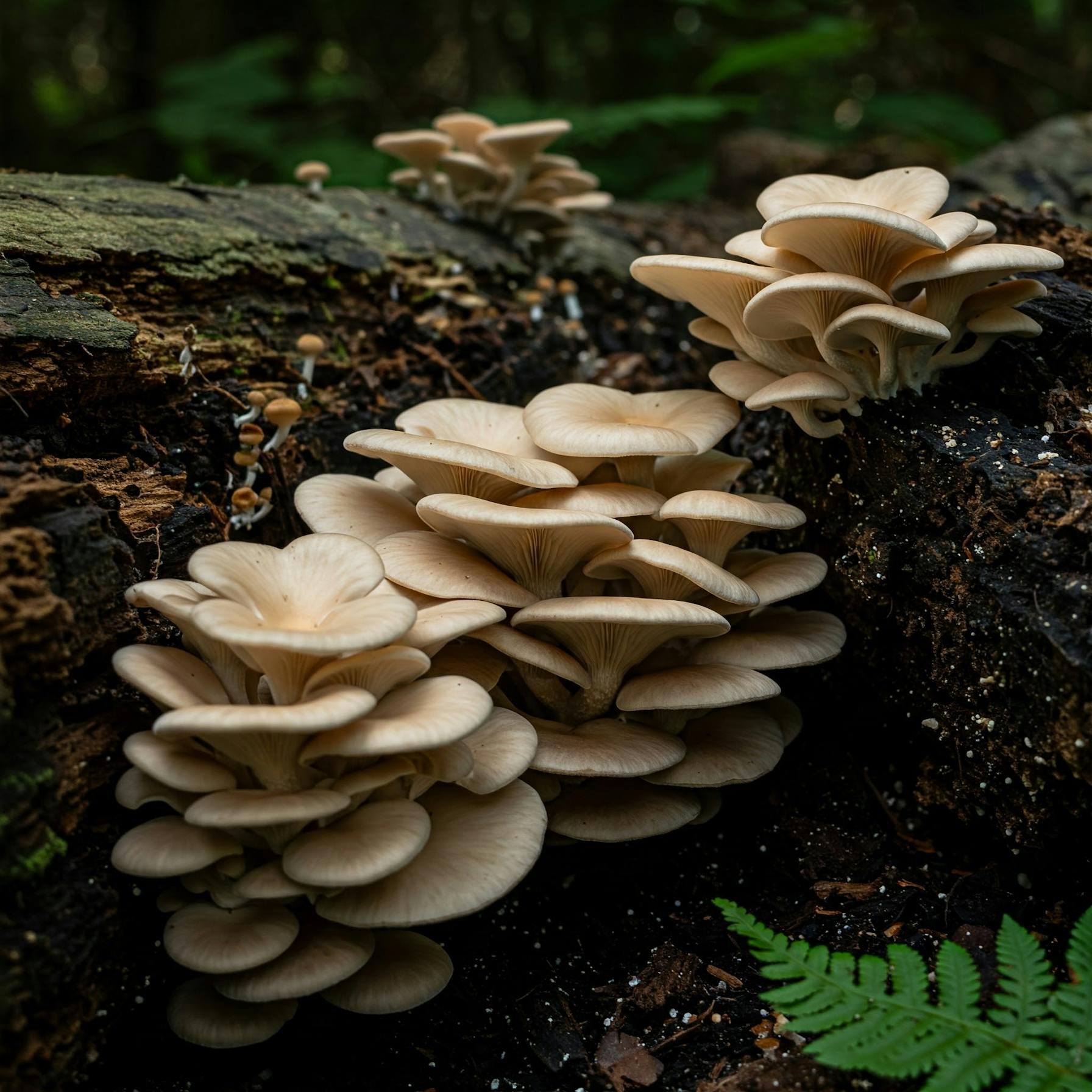
 Jason Burson
Jason BursonMeet the Mushroom: Pearl Oyster Mushrooms
Welcome to our first installment of "Meet the Mushroom," where we spotlight the fascinating fungi we grow here at Emory Market Gardens. Today, we're excited to introduce you to the elegant and versatile Pearl Oyster Mushroom!
What Are Pearl Oyster Mushrooms?
Pearl Oyster Mushrooms (Pleurotus ostreatus) are one of the most widely cultivated mushroom varieties in the world. With their delicate shell-like shape, pearly white to light gray color, and velvety texture, these mushrooms are as beautiful as they are delicious.
Native Habitat
In the wild, Pearl Oyster Mushrooms are nature's recyclers. They're typically found growing in shelf-like clusters on dead or dying hardwood trees, particularly beech and aspen. Native to temperate and subtropical forests around the world, these opportunistic fungi help break down dead wood and return nutrients to the forest ecosystem.
What makes Pearl Oysters remarkable is their adaptability. From North America to Europe and Asia, these mushrooms have made themselves at home across the globe, thriving in diverse woodland environments.
How to Identify Pearl Oyster Mushrooms
Proper identification is crucial when foraging for mushrooms. Here's how to recognize Pearl Oyster Mushrooms:
- Shape: Look for fan or oyster shell-shaped caps growing in overlapping shelf-like clusters. Young specimens have inrolled margins that flatten with age.
- Size: Caps typically range from 2-10 inches (5-25 cm) in diameter.
- Color: Pearl white to light grayish-brown, sometimes with subtle blue undertones in young specimens.
- Gills: Distinctive decurrent gills (running down the stem) that are white to cream-colored and closely spaced.
- Stem: Short, stubby, and often off-center or absent. When present, stems are whitish and firm.
- Smell: Fresh specimens have a mild, pleasant anise-like aroma.
- Spore Print: White to lilac-gray.
- Habitat: Always found growing on wood (never from soil), typically in shelf-like formations on logs, stumps, or standing dead trees.
Look-alikes: Angel Wings (Pleurocybella porrigens) can appear similar but are pure white and grow exclusively on conifer wood. The Elm Oyster (Hypsizygus ulmarius) has a more central stem and grows primarily on elm trees. Always consult an expert mycologist if you're uncertain!
Ideal Growing Conditions
Here at Emory Market Gardens, we mimic these natural conditions to grow perfect Pearl Oysters:
- Temperature: Pearl Oysters prefer moderate temperatures between 55-65°F (13-18°C) for fruiting, though they can tolerate a wider range.
- Humidity: High humidity (85-95%) is essential, especially during the pinning stage.
- Light: Unlike many plants, mushrooms don't photosynthesize, but Pearl Oysters do need some indirect light to trigger proper development and prevent strange growth patterns.
- Substrate: We use a master mix for our Pearl Oysters, providing the perfect nutrient balance to mimic their natural wood-based diet.
- Air Exchange: Fresh air is crucial - too much CO2 can result in thin stems and small caps.
One of the reasons we love cultivating Pearl Oysters is their impressive efficiency at converting substrate into food. They're among the fastest-growing mushroom varieties, often ready to harvest just 14-21 days after spawning.
Culinary Excellence
Pearl Oyster Mushrooms have earned their gourmet status for good reason:
- Flavor Profile: They offer a mild, subtly sweet flavor with hints of anise and a delicate seafood-like quality that becomes more pronounced when cooked.
- Texture: When cooked, Pearl Oysters develop a wonderful velvety, meaty texture that makes them perfect for vegetarian dishes.
- Versatility: These mushrooms shine in stir-fries, soups, pasta dishes, and risottos. They can be sautéed, grilled, roasted, or even battered and fried.
- Nutritional Value: Low in calories but high in protein, B vitamins, potassium, copper, iron, and antioxidants, Pearl Oysters are as nutritious as they are delicious.
Cooking Tips from Our Farm Kitchen
To bring out the best in our Pearl Oyster Mushrooms:
- Tear rather than cut them to preserve their delicate texture
- Sauté over high heat until they release their moisture, then continue cooking until golden
- Try not to crowd the pan - mushrooms need space to caramelize properly
- A simple preparation of butter, garlic, and fresh herbs lets their natural flavor shine
Sustainability Stars
Beyond their culinary appeal, Pearl Oyster Mushrooms represent sustainable food production at its finest. They require minimal resources to grow, can be cultivated on agricultural by-products like straw and coffee grounds, and produce harvestable food in a fraction of the time needed for conventional crops.
At Emory Market Gardens, we're proud to offer these ecological champions as part of our commitment to sustainable, local food production.
What's Next in "Meet the Mushroom"?
We'd love to hear from you! What mushroom variety would you like to learn about in our next installment? Are you curious about the medicinal Lion's Mane, the stunning Pink Oyster, or perhaps the coveted Shiitake? Let us know here.
Share your mushroom interests and questions with us here, and don't forget to check out our fresh Pearl Oyster Mushrooms at the market this weekend!